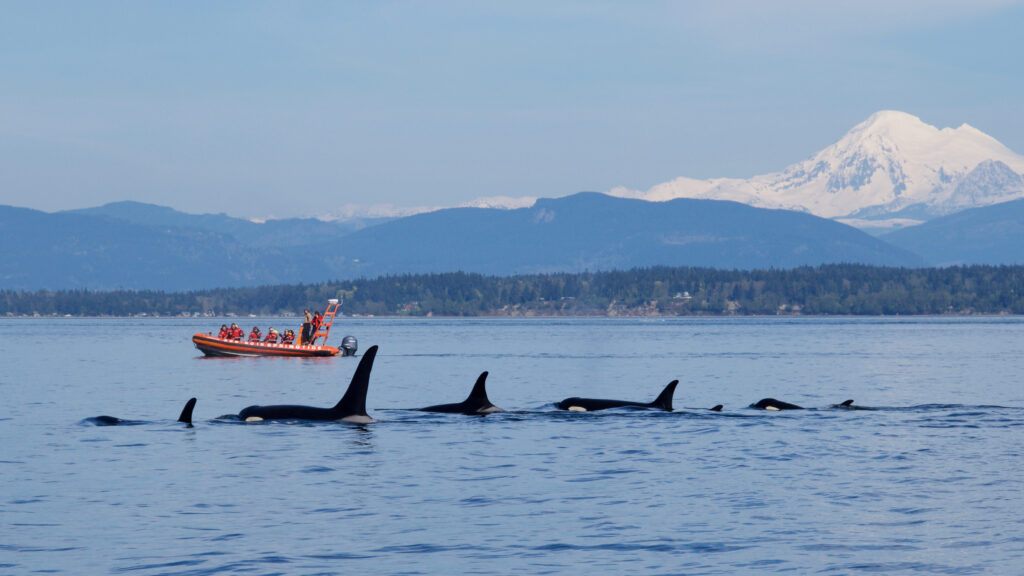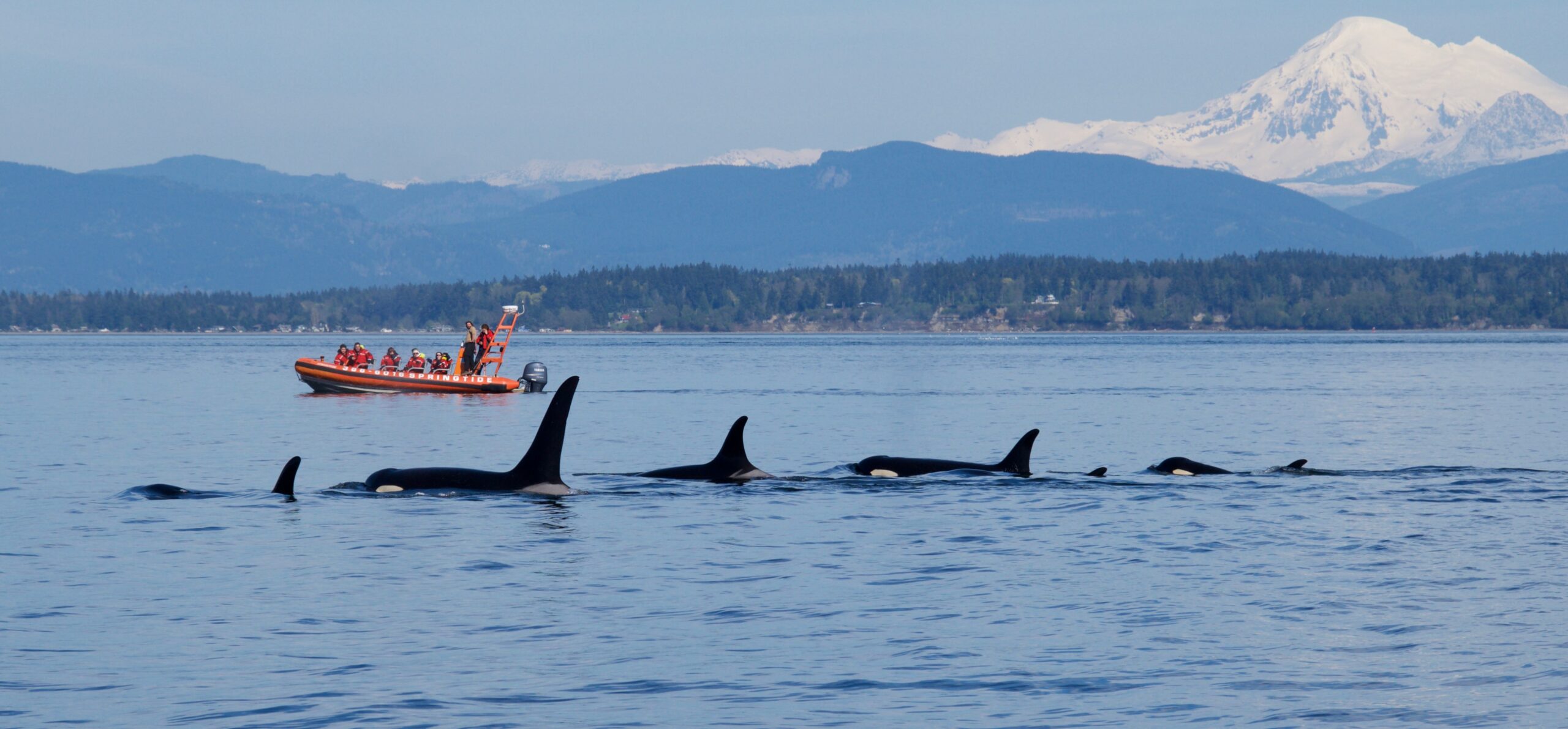Everyone has questions about whales and the other marine wildlife we have here in the Salish Sea. We decided we would answer the Whale and Wildlife FAQ’s that we get here at SpringTide to give everyone interested a bit more information about these beautiful animals that we get the see in the wild.

1. Is an Orca and Killer whale the same thing?
Yes, the term “Orca” and “Killer whale” refers to the same animal. The name “Orca” comes from their scientific name Orcinus Orca, which actually means “demon from hell”. Unfortunately, for centuries orcas had a bad reputation for being vicious, savage creatures, which is where this scientific name came from. Now that we have learned more about these mammals, we know that wild orcas are not dangerous to humans, and we have no reason to fear them. “Killer whale” is the common name for orca (similar to using the name dog to describe a canine), which was given to them by Spanish Whalers from the Spanish translation “Ballena asesina” (whale killer). The Spanish gave them this name because they observed orcas hunting other types of whales (for example, grey and mike whales). Over time, and most likely through error in translation, “whale killer” became killer whale in English. Therefore, using the name orca or killer whale to describe these animals are both correct.
2. What is the difference between Transient and Resident Orcas?
The three major differences between Transient and Resident orcas are their diets, pod sizes, and behaviour. Resident orcas feed almost exclusively on Chinook salmon, while Transient orcas eat only marine mammals such as seals, sea lions and porpoises. You will never catch a Resident orca eating a mammal, and conversely, a Transient orca would never hunt a fish. Resident orcas live in large pods or families, generally around 20-40 members. Transient orcas travel in much smaller pods, on average groups of about 4-8 members. Lastly, Resident orcas spend almost half of the year off the southern tip of Vancouver Island (which is how they got their name “southern resident”), and the other half following around the Chinook salmon. Transient orcas are constantly traveling; these whales do not have one specific area they ever call home. Transients travel up and down the west coast of Canada and the United States, going as far south as about California, and as far north as Alaska.
Although morphologically Resident and Transient orcas look very similar, they are considered different sub-species of orcas. They will not interbreed with one another (and have not for tens of thousands of years), and they cannot communicate. A Resident orca would never join a Transient pod, and vice versa. To each other Resident and Transient orcas might as well be a completely different species of whale.
3. Why do Resident and Transient orcas have different diets?
As mentioned above, Resident orcas exclusively eat fish, and Transient orcas only eat marine mammals such as seal, sea lions and porpoises. Despite being considered different sub-species (but not different species), Resident and Transient orcas are genetically distinct from one another. Often, animals need to be separated by some sort of physical barrier (for example a mountain or a river) in order to branch into different species over time. Scientists believe orcas may be one of the only unique cases where branching into different sub-species has occurred because of what they chose to eat. As a result of this variation in diet, fish eaters only mate with fish eaters, and mammal eaters only mate with mammal eaters, which over thousands of years has led to distinct populations and species within these groups. These individual diets have led to unique hunting strategies and behaviours, which over time would contribute to creating major cultural differences, further dividing the populations. For example, Resident orcas are known to be extremely vocal underwater, communicating with each other over long distances. Conversely, Transient orcas tend to be very silent underwater while hunting for marine mammals, such as seals, that have good hearing. Over time, those learned hunting behaviours would also become common social behaviours within the pod. Furthermore, because Resident and Transient orcas do not interbreed, there is no genetic mixing within the different groups, increasing that branching into distinct lineages.
4. Do you always see whales in the same area?
Not necessarily. Depending on the species of whale, there are certain spots they may spend more time in compared to other areas. For example, our Southern Resident orcas can often be found close to San Juan Island during the summer months, as there is a higher abundance of salmon near that area. Conversely, the humpback whales that come into the Strait of Juan de Fuca are often migrating north or south in the open Pacific Ocean, and therefore generally spend more time feeding west of Victoria. That being said, whales are wild animals that can travel upwards of 100 km a day, so we cannot always predict where they are going to be. The only certainty with whale watching is that every day is going to be different!
5. How do you tell the difference between individual whales?
We are able to visually identify an orca based on two features: their dorsal fin and saddle patch. Many orcas often have scars, scratches or nicks on their dorsal fins that they acquire while hunting or traveling too close to rocks. In addition, the saddle patch, which is located behind their dorsal fin, is unique to each whale, acting like a finger print. Depending on the whale, a saddle patch can be different shades of white or grey, or have patterns such as swirls or blocks of black inside of it. Using these two features together helps us identify individual orcas within our Southern Resident population and Transient orca populations, and allows us to keep track of these whales in a non-invasive way. Humpback whales can similarly be identified using their fluke or tail, which they often put above the surface of the water when they are beginning a deep dive.
6. Why do whales breach?
The answer to this question truthfully hasn’t been unanimously agreed upon by scientists, but there are a few theories behind why whales may breach. For whales that live within pods, such as orcas, it is theorized that breaching may be a social behaviour used to communicate with one another. In our area, breaching often occurs when many pod members or multiple pods are grouped together, and is accompanied by other social behaviours such as tail slapping, rolling and spy hopping. For this reason, scientists think that orcas may breach more for fun than for practical reasons. For larger whales, it is hypothesized that breaching may be a way for them to knock parasites off their bodies, or “scratch” themselves. Some species of whales such as humpbacks and grey whales often accumulate small marine invertebrates such as barnacles growing on them, which can add unwanted weight for them to carry around. Breaching could therefore be a way for them to knock off some of these small organisms.
7. How long can orcas hold their breath?
The answer to this question can involve several factors, such as what the whale is doing and how deep it is diving. If the orca is traveling quickly and expending a lot of energy, it will need to breathe more frequently. Similarly, if the whale is going on a deeper dive, it is more likely it will be under the water holding its breath for a longer period of time. The longest recorded dive for an orca clocked in at about 20 minutes; however this is very uncommon. In most cases, our Resident killer whales will be surfacing on average every 2-3 minutes.
8. Why do orca calves appear black and orange when first born?
For orcas that are less than six months old, the white patches on their body appear orange or peachy in colour. Scientists believe this is because when a calf is first born, it does not have a very thick blubber layer, and small blood vessels are showing through their white skin, giving it an orange appearance. After approximately six months, and once the orca has had a chance to build up its blubber layer, the peachy colour fades into white, similar to that of an adult orca. This interesting colour combination for newborn calves is often helpful to us, as it makes them very easy to spot against the stark colouring of their parents.
9. What is the difference between a dolphin and porpoise?
The term whale, dolphin or porpoise are regularly used interchangeably to describe a mammal within the order cetacean, sometimes incorrectly. For example, the orca, which is commonly known as a killer whale, is actually the largest species of dolphin. There are three major differences between dolphins and porpoises, which are primarily due to the shape of their teeth, dorsal fin, and beak. Dolphins, similar to humans, have cone-shaped teeth, while porpoises have spade-shaped teeth. Dolphins generally have a curved or hooked dorsal fin, which differs from the triangular shape of a porpoise’s dorsal fin. Lastly, dolphins tend to have a more elongated beak (for example the bottle nose dolphin), whereas porpoises generally have a rounded beak. Other than these small differences, dolphins and porpoises are quite similar, and are both very intelligent marine mammals.
10. Are there sharks in the Salish Sea near Victoria?
There are 14 different species of sharks living in the Salish Sea, however most of them are benthic, which means they live at the bottom of the ocean. As a result, we hardly see any of these sharks at the surface, because, unlike our marine mammals, they can breathe underwater. There are a few species of sharks in our area that feed near the top of the water column, which sometimes makes it possible for us to see them at the surface of the water. An example of this is the basking shark, which is rare in the Salish Sea as they are very endangered. Basking sharks feed on small organisms such as zoo plankton and krill using “gill rakes” in their mouth to filter feed. These small organisms are found in the euphotic zone (sunlit zone), which is on average the top 100 feet of the water column. Therefore, while these sharks are feeding, they sometimes come close enough to the surface for us to be able to see them, although it does not happen very often.
These are only a few of the common questions we are asked by our guests. If you have more Whale and Wildlife FAQ’s, please ask away! You can find us on Facebook, Twitter, Google+ and Instagram!

